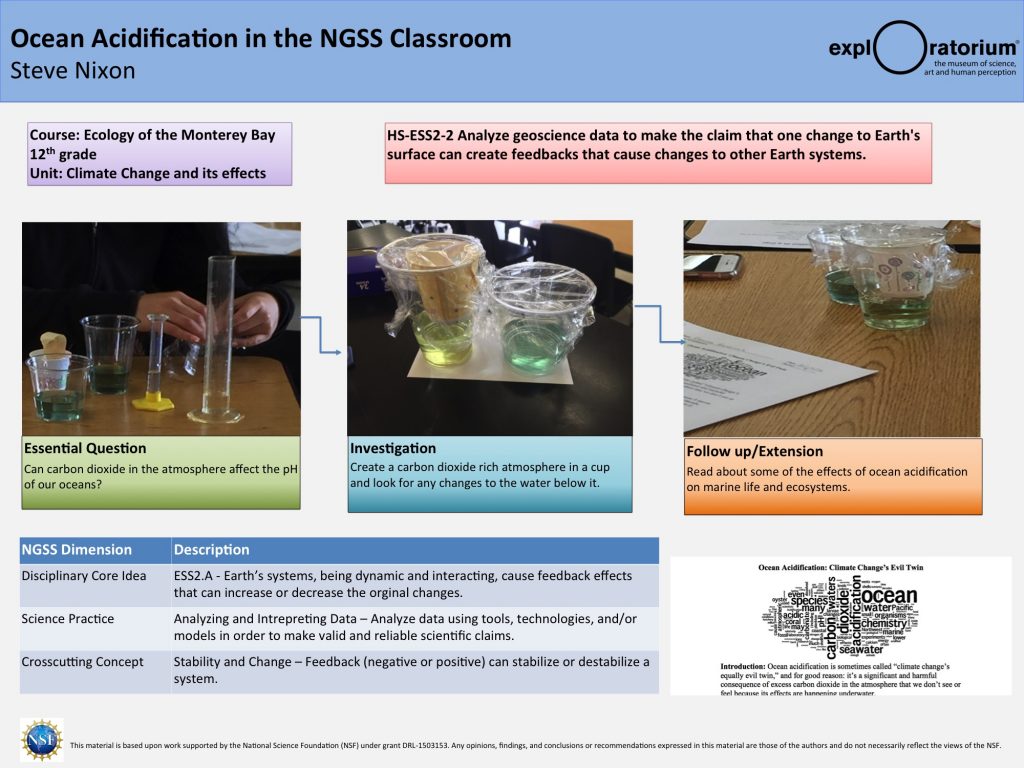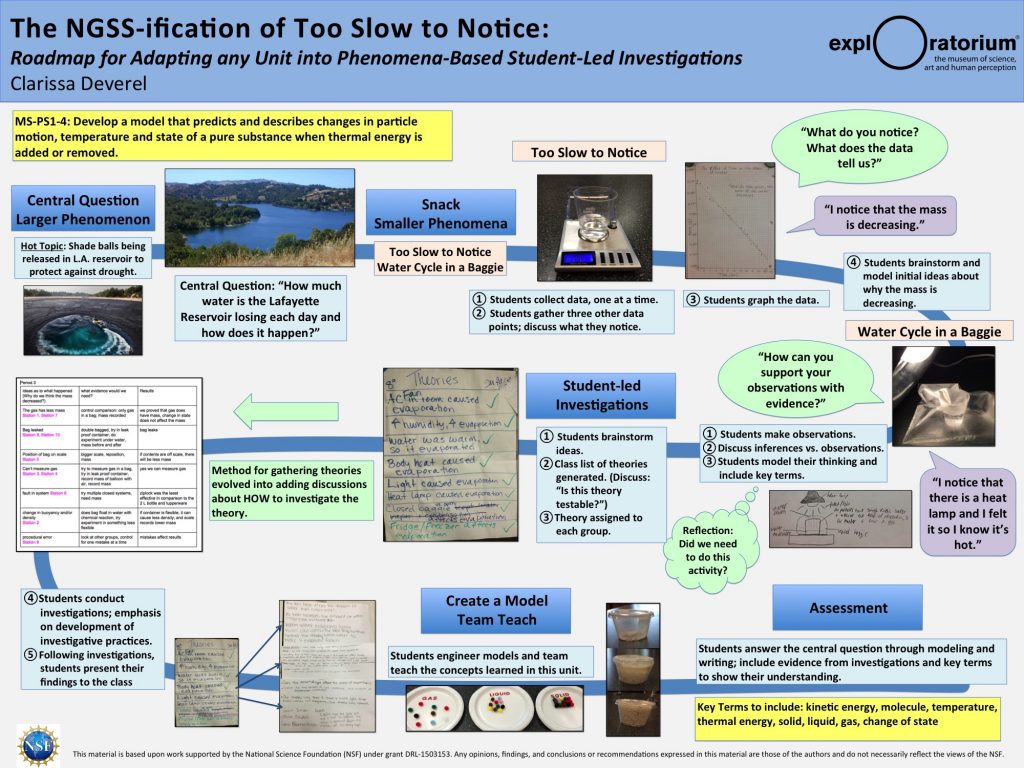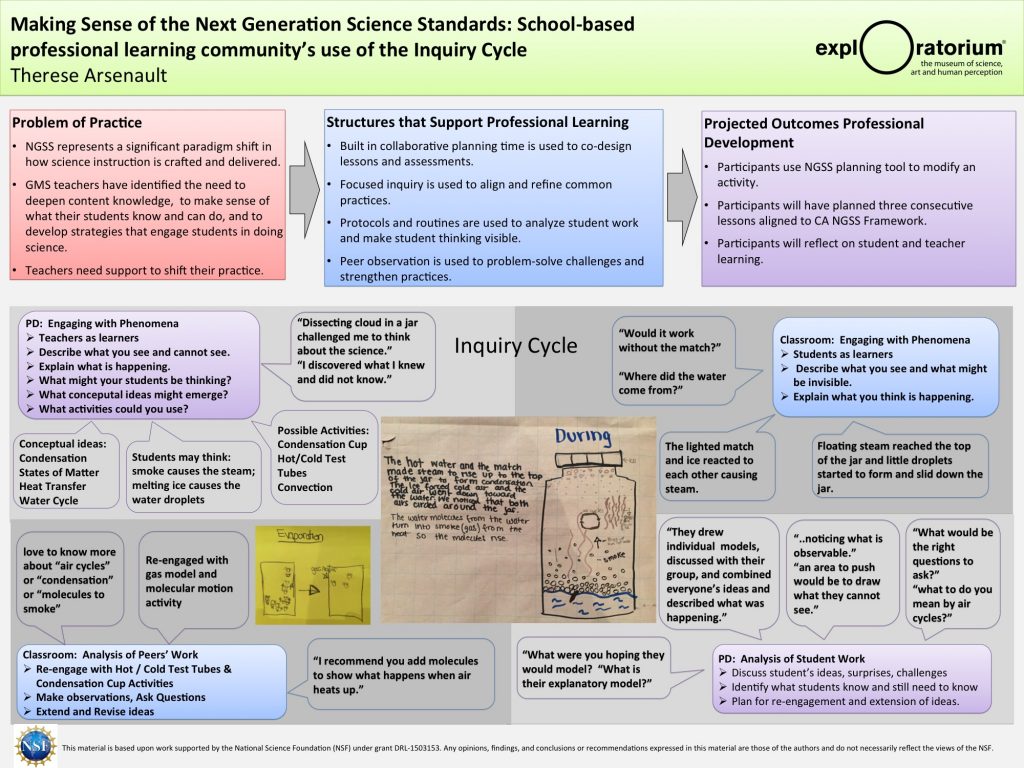Feature
A Hub for STEM Learning
Connected Science Learning November 2016-January 2017 (Volume 1, Issue 2)
By Julie H. Yu and Sara C. Heredia

The Exploratorium Teacher Institute leverages a network of teachers, education researchers, practicing scientists, and informal education staff to address the professional learning needs of secondary science teachers.
Frank Oppenheimer, founder of the Exploratorium, a museum of science, art, and human perception in San Francisco, is often quoted as saying, “No one ever flunked a museum.” On the surface of this statement are the inherent expectations people have of science museums: engagement and play versus the standards and grading associated with formal schooling. Underpinning these ideas are assumptions about learning, collaboration, resources, and value that vary depending on audience. Informal science settings are recognized for their potential to contribute to science learning due to their physical environment (NRC 2009), which should be extended to capitalize on the variety of people who seek engagement with science-rich institutions. Indeed, informal science institutions offer different types of accessibility and opportunity to families, teachers, administrators, scientists (both from industry and academia), education researchers, and informal educators. These locations can serve as a hub that connects players who may otherwise encounter difficulties collaborating due to lack of understanding of each other’s contexts (Penuel et al. 2015). Teachers attending professional development at a university may feel that researchers providing the training do not understand classroom challenges. Researchers may be frustrated by seemingly inexplicable administrative and logistical challenges when collecting data in a school district. Scientists may visit a classroom assuming their content knowledge is a comprehensive contribution, without consideration for pedagogy. Each of these parties has a unique and direct relationship with informal science institutions, which can provide a supportive, trusted, neutral ground to connect stakeholders in science education. At the Exploratorium we rely on these connections to be the spokes of opportunity that drive our capacity for developing both staff educators within the museum as well as teachers who participate in our programs.
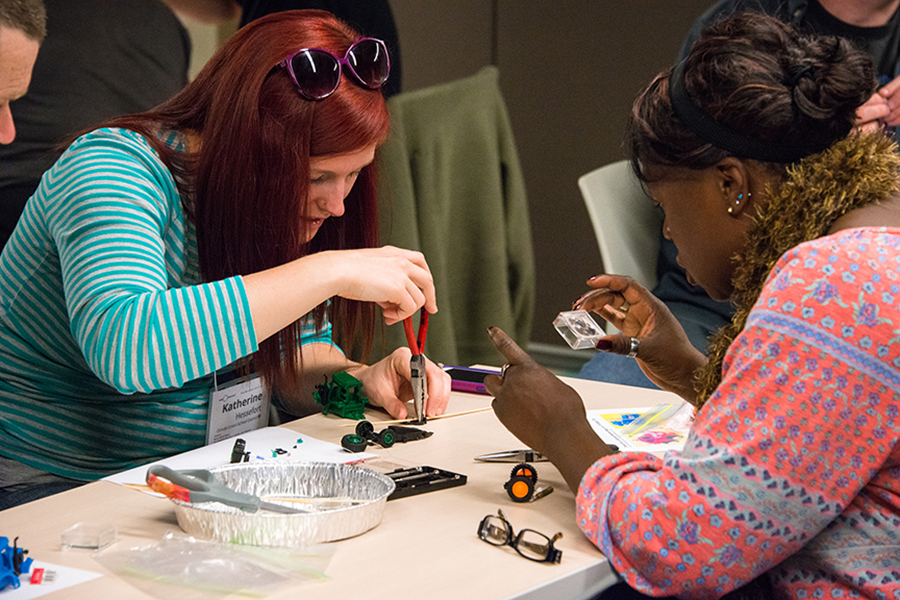
The Exploratorium Teacher Institute
The Exploratorium Teacher Institute (TI) is a teacher professional development center that offers comprehensive, multiyear professional learning institutes; classroom coaching and mentoring; and teaching tools to middle and high school science teachers. The TI staff is composed of a team of PhD scientists and veteran secondary science educators who work in concert to provide teachers with resources and experiences that develop the content knowledge and pedagogical skills necessary for teaching authentic science content through student-centered activities (McDermott and DeWater 2000). All of this is situated within the Exploratorium’s historical tradition of open-ended, constructivist learning, which provides a level of comfort coupled with minimally defined expectations that can increase teacher confidence with using inquiry-oriented practices (Astor‐Jack, Balcerzak, and McCallie 2006).
TI programs are differentiated and intentionally blended for novice-, experienced-, and leadership-level teachers. These programs provide professional learning opportunities for all points of a teacher’s career, including a two-year Teacher Induction Program for novice science teachers and a complementary Teacher Leadership Program that trains experienced teachers to support those new to the profession. Most participants begin their involvement with a three-week, 100-hour summer institute, and they are invited to return for additional programming for the rest of their careers, resulting in a growing community of over 3,000 teachers. Additional programming includes Saturday workshops during the academic year, one-week summer institutes specifically for alumni, and online workshops. Teachers continue their engagement in a multitude of ways, from participating in an email listserv to leading professional development for other teachers. There is a strong emphasis on professionalism, and teachers typically receive a stipend for their participation in any program. Together, this creates a network of sustained and science-specific support outside of their schools and districts (NAS 2015).
A Collaboration Between Scientists and Teachers
Though the program was started by scientists who had made a career transition to informal education, the staff quickly realized that collaboration and partnership with classroom teachers was essential for providing effective support. This manifested in hiring experienced classroom teachers to join the staff, as well as soliciting and implementing feedback from classroom teachers to help design programming. The result continues to catalyze a true collaboration between staff educators, staff scientists, and teacher participants and leverages the resources of the museum to support teachers’ immediate and long-term needs.
Since its inception in 1984, TI has designed its programs to address the current needs of teachers and help them implement educational reform by recognizing and building from wherever they are in the professional learning continuum. The program began in response to local physics teachers wanting to transport the learning experiences of the museum into their classrooms. Over time, program content expanded to include disciplinary content areas beyond those that exist on the museum floor. Because teachers continued their involvement beyond the initial interaction of the summer institute, what would otherwise have been a group of one-time participants grew into a community of educators dedicated to improving science education. In the late 1990s, the community expressed concern that a shortage of science teachers was leading to an increasing number of novice science teachers who left the classroom after a few years. In response, TI created a science-specific Teacher Induction Program to support novice teachers and recruited experienced classroom teachers from the community to serve as mentors. By continually seeking and addressing feedback from practicing teachers, the single program evolved into a professional development center, with multiple short- and long-term opportunities through which teachers can receive support.
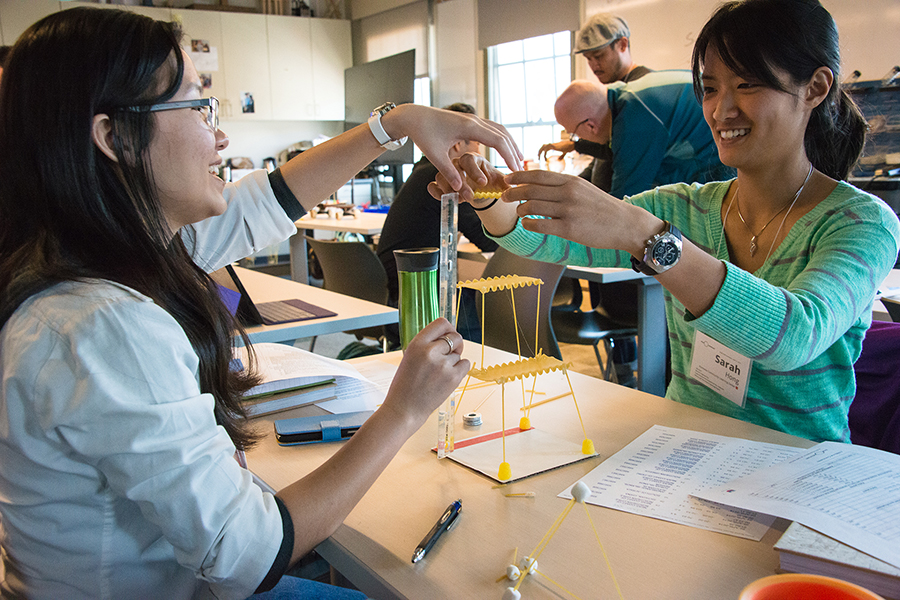
The Current Need to Address the Next Generation Science Standards
[Next Generation Science Standards-oriented] professional development should not only be rich in scientific and engineering practices, crosscutting concepts, and disciplinary core ideas but also be closely linked to teachers’ classroom practice and needs. … The capacity of the informal science learning sector to support effective teacher development will also need attention to ensure that the work that such institutions as science museums do in teacher professional development is likewise aligned to the framework’s vision. —A Framework for K–12 Science Education (NRC 2012, pp. 259–260)
Implementation of the Next Generation Science Standards (NGSS) is the current focus for both teacher participant and TI staff development. One of the most significant ways that the NGSS differ from prior standards is that they specify that each performance expectation must combine a relevant science and engineering practice with a disciplinary core idea and a crosscutting concept, referred to as the three dimensions of learning (NGSS Lead States 2013). Although many of the teachers in our programs are familiar with engaging students in manipulative-based experiences, classically known as the “hands-on activity,” simply having students participate in a directed version of these activities is likely not sufficient to support full understanding of the three dimensions of the NGSS. The emphasis on science practices demands that teachers move away from dispensing knowledge or orchestrating step-by-step hands-on activities to investigations that involve student questioning, experimental design, data collection, and, most importantly, reflection and synthesis. Supporting student learning through engagement in three-dimensional science learning will require teachers to shift their teaching practices (NRC 2012), which has elicited great concern and attention from teachers, administrators, and professional development providers.
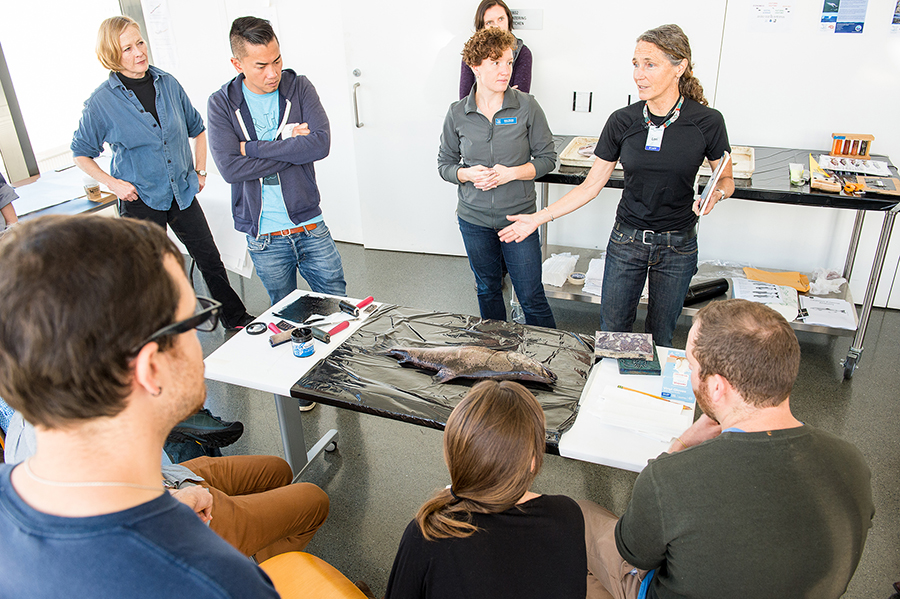
Analogous to learning science content via STEM practices, there is growing consensus that teacher professional development needs to move beyond simply providing teachers with knowledge about reform to focus on supporting teachers in developing the classroom practices necessary to implement reform in their classrooms (Darling-Hammond 2010; Windschitl 2002). The shift in teaching practice called for by the NGSS does not resemble the ways in which most teachers gained discipline content knowledge themselves. Many teachers who have learned science primarily through direct instruction at the college level are likely to emulate those teaching practices in their own classrooms (McDermott and DeWater 2000). To support their use of inquiry in teaching, science teachers require professional learning experiences that provide them with instruction on both the content and process of science, preferably taught by scientists who also understand the needs of teachers (McDermott 2006). By learning the way students are expected to learn, teachers can work through the material and identify potential difficulties their students may have, while also developing a deeper understanding of the content (McDermott and DeWater 2000).
TI has long employed this model of professional learning as a core strategy, placing teachers in active learning situations to support metacognitive insights that help them create similar experiences for their students. Workshops often begin on the museum floor, a space designed and understood to be an environment for open-ended learning. Staff educators use exhibits to facilitate teacher learning of content through experiencing phenomena and conducting investigations. For example, one exhibit, the Echo Tube, is a 60-meter metal duct where visitors can clap at one end and hear the clap’s echo a fraction of a second later. Rather than being told that sound is a wave that travels at a specific speed, teacher participants conduct investigations at the Echo Tube to estimate the speed of sound with nothing other than a stopwatch. Their understanding of the speed of sound is therefore tied to an investigation and resulting evidence, rather than a number in a textbook. We believe that to meet the challenge of providing three-dimensional learning opportunities for their students, teachers need to engage in such experiences themselves. Providing these professional learning opportunities in an informal setting allows access to resources, both physical (through exhibits) and human, that can support strands of science learning identified in the NRC report (2009) on learning in informal environments, many of which include engaging in science and engineering practices as described in the Framework (NRC 2012).
Professional Learning That Builds on What We Know
Teachers, like students, have knowledge and previous experiences that can be leveraged for their learning. A constructivist perspective of teacher professional learning should reflect this understanding and make use of teachers’ previous experiences and assets as resources for their growth. We believe that professional learning can be structured and implemented in ways that help teachers recognize that transitioning to an NGSS-oriented classroom is not necessarily about radically changing the way they teach, but about making strategic adjustments to their familiar practices and routines to help students recognize and reflect upon the scientific practices in which they are engaging. Rather than adopting a deficit view of teachers as lacking experiences for implementing STEM practice–rich programs for students, we are working to design professional development that builds from an assets-based view of teachers’ existing professional interests, routines, and teaching tools as important resources for their learning. From our position as a hub for various stakeholders in science education, we extend this assets-based approach to professional learning opportunities for all parties, including external partners and our own staff, as we all work together to attend to the needs of secondary science teachers. In the following sections, we describe these efforts to collaborate with classroom teachers, educational researchers, and research scientists.
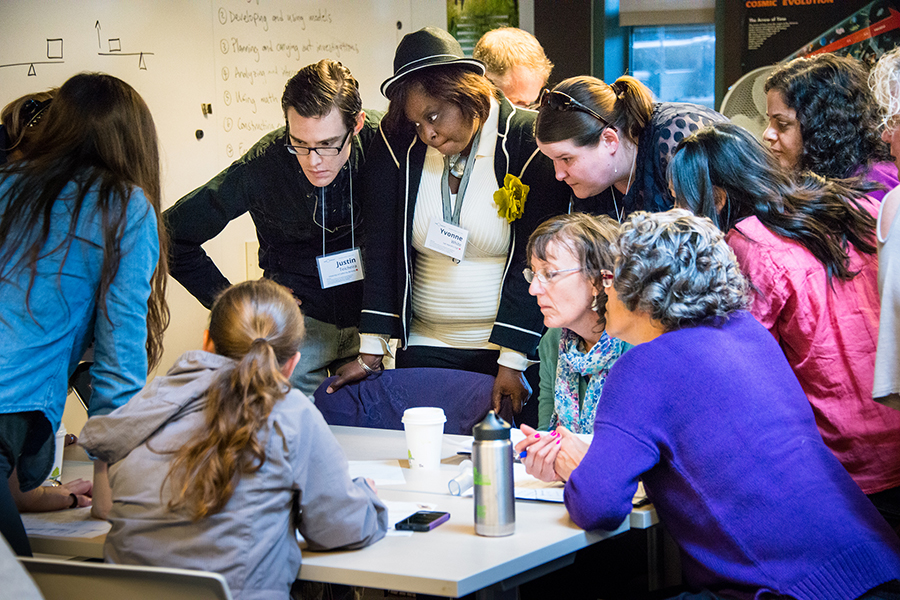
Integrating Teacher Expertise
An evaluation of TI’s Teacher Induction Program identified that one of the key features of its success is providing lessons and resources to meet beginning teachers’ immediate needs while building a foundation for developing their pedagogy and long-term teaching practices (Hirabayashi and Stokes 2006). For example, participants talked about gaining activities that they could use with their students: “What you are also getting is stuff that is useable in class, but they are not little set pieces like artificially constructed things that you just follow along and do, it is actual inquiry and it is real science” (Hirabayashi and Stokes 2006, p. 18). At the same time, the professional development supports participants’ long-term use and understanding of the teaching practices of inquiry through modeling, as they engage as learners in those same activities: “What makes these TI classes distinctive is that the teachers who teach us model exactly what it is that they are teaching us. They model what it is to have hands-on, interactive science” (Hirabayashi and Stokes 2006, p. 16). Throughout programming at TI, we attempt to integrate the immediate needs of teachers (providing usable activities for the classroom) with supporting their development of inquiry classroom practices by modeling how to use those activities with their students.
With funding from the National Science Foundation’s (NSF) Discovery Research PreK–12 program, we are expanding on this foundation to develop tangible resources for supporting implementation of three-dimensional science learning and opportunities for teachers to build their skills and understanding for sustained incorporation of science and engineering practices in their classrooms. We developed a one-week, 30-hour institute that engages teachers as learners in practice-rich, three-dimensional learning experiences on the museum floor and in our classroom space. These experiences acted as resources for teachers to draw on as they worked collaboratively with colleagues to design similar learning experiences for their own classrooms. Each day of the workshop, teacher participants spent the morning as science learners as we modeled three-dimensional learning experiences. Then, in the afternoon, we deconstructed those activities as teachers to think about how the learning was organized around each of the dimensions in the Framework. Teachers then had time in grade-level groups to modify activities of their own choosing to include each of the three dimensions, similar to the activities they experienced that morning. This project also offered follow-up sessions for teachers that provided opportunities to discuss their enactment of activities designed over the summer workshop and to look at examples of students’ work. Teachers also shared successes and challenges associated with implementation of the NGSS in their classrooms.
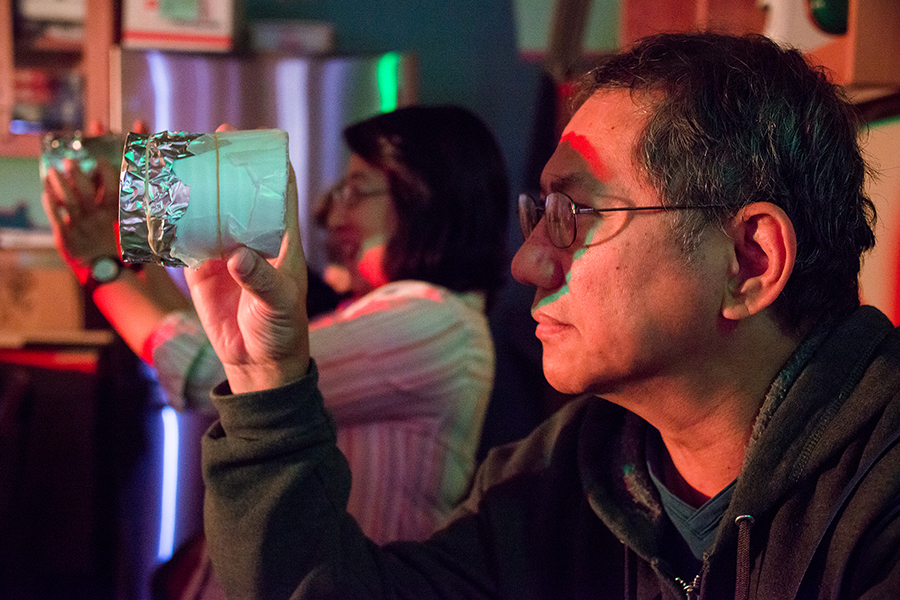
Three teachers who changed existing hands-on activities into investigations that more deeply engaged students in the science practices presented their experiences at a symposium at the end of the school year. The symposium was attended by teacher participants, TI staff, and educational researchers who served on the project’s advisory panel. One teacher modified an activity called Ocean Acidification in a Cup. The activity describes how students can set up a system that provides evidence that water beneath a carbon dioxide gas–rich environment becomes acidified. Students then discussed how the experiment related to data collected by climate scientists and tied it to what is happening in their local ecosystem in the Monterey Bay. Students used evidence to show that a change in one part of a system can cause feedback effects in other systems (disciplinary core idea), analyzed and interpreted data that are used to make claims about Earth’s systems (science practice), and discussed how that feedback is disrupting a stable system (crosscutting concept), all within the context of their local environment.
Initial review of video-recorded workshop conversations and follow-up surveys of teacher participants suggest that the experience of learning science in a three-dimensional way was a valuable resource for teachers to leverage as they prepared instructional plans for their classrooms. For example, one teacher wrote, “I appreciated having the opportunity to experience science lessons from the museum staff members and the follow-up opportunity to develop ideas with colleagues. It was wonderful to see the process of teaching ‘snacks’ and modeling phenomena first before design or creating experiences for my own students/classroom curriculum” (Exit Survey, Summer 2015).
There was variation in the extent to which teachers were able to enact the activities designed during the one-week institute. Some teachers felt limited in their ability to implement due to lack of administrative or district support at their school sites. Addressing this common hurdle is a key focus for us as we iterate and continue to develop our professional learning model to best support teachers’ implementation of the NGSS. Further research developed from this project will provide critical evidence for how TI and other providers of professional development can leverage existing resources within teachers’ professional repertoires to support their learning and sensemaking of the NGSS.
Integrating Education Researchers
A few years ago, TI added an education researcher to our staff to use our professional learning community to investigate teacher learning and teach alongside our practitioners. The ready knowledge of best practices from the research community has increased staff reflection and articulation of how we support teacher learning and how we can contribute more broadly to the field at large. Participating in the design-based research project described in the previous section has contributed to our own professional development as teacher educators. Note that we, too, have taken an assets-based approach and built on prior work to best address the NGSS. Over three decades, TI staff and participant teachers have developed hundreds of science snacks, student-centered activities that use low-cost, readily available materials and are designed to be accessible for use regardless of classroom budget. These activities were previously developed to provide student-centered, inquiry-based avenues that use physical representations of science to teach content described in prior national and state science standards (NRC 2007). The essential features of inquiry used to develop these activities map directly to the NGSS practices of Asking Questions, Designing Investigations, Constructing Explanations, Engaging in Argument From Evidence, and Communicating Information (NRC 2000; NGSS Lead States 2013). A number of these activities include further opportunities to engage in the practices of Developing and Using Models, Analyzing and Interpreting Data, and Using Mathematical and Computational Thinking. As part of the NSF project, our educators and researcher developed a planning tool to help teachers modify their existing hands-on activities into three-dimensional investigations. This tool was used by all three teachers in the development of the activities described in the posters in Figure 1. As we used the tool with teachers in multiple workshops, we noticed that it was equally useful for professional developers who are preparing to work with teachers, as it is essentially an articulation of the process we use when developing an existing snack activity into an NGSS practice–rich investigation. This process, not unlike what we hope for our teacher participants, has greatly contributed to our staff’s understanding of three-dimensional learning and how we can support teachers to create such experiences for their students.
Integrating Research Scientists
We are also using the scientific research community to help teachers understand how the science and engineering practices delineated in the NGSS describe the work and habits of scientists and engineers. TI regularly receives requests from scientists who seek opportunities for outreach and dissemination of their work. We play a critical role in brokering the relationship between practicing scientists and classroom teachers, both by ensuring the resources provided are relevant to teachers and by engaging scientists in the practical problems and challenges in the classroom. A key factor in these relationships are the Exploratorium staff scientists, who have lab research experience and have dedicated their professional lives to working with teachers and understanding their needs. These staff members have experience in both worlds and can attend to considerations between teachers and scientists that may arise due to the differences in work environments, language and jargon, and classroom expectations. This requires staff and time investments that may challenge the capacity of the hub organization, but we have found that it contributes greatly to the impact that an outside scientist can have.
A current project funded by a Science Education Partnership Award from the National Institutes of Health, Digital Teaching Boxes, brings in practicing scientists to work with teachers to create digital resources for their classrooms. These tools are based on primary sources, which include the scientists’ data or images developed by the teachers at the Exploratorium. For example, Bill Sullivan, professor of molecular, cell, and developmental biology at the University of California, Santa Cruz, studies cell division. TI staff worked with members of the Sullivan lab to use videos that had been taken for research on drosophila embryos to create an activity to help students understand critical events in mitosis. Teacher participants then selected videos where they could highlight features they wanted their students to understand. Sullivan also participated in the workshop to provide content expertise for both teachers and museum staff, as well as participate in the discussion on how his research tools and products could be used in the K–12 classroom.
Again, a critical component in this project is allowing teachers to leverage existing resources they already use and build on them with supporting expertise from scientists and museum staff. The visiting scientists see their work in the context of a current K–12 classroom, as opposed to their research lab or their own school experience. They are exposed to and gain an opportunity to support science teachers by building from the teachers’ knowledge and needs. The professional development for both is mediated by TI’s staff, who themselves model a partnership between teachers and scientists.
Driving the Network
Informal science institutions are uniquely positioned to bring together the variety of stakeholders who are critical to impacting STEM learning for teachers and their students. This is not unlike the currently popular idea of STEM ecosystems (NRC 2014); with TI, however, the informal science institution plays the intentional role of serving as the hub that connects each part of the system. Informal science institutions can additionally focus on leveraging the system to connect and develop practitioners rather than solely concentrating on providing opportunities for youth, as described in many STEM ecosystem approaches. The hub should take advantage of local resources and be modular, allowing different arms to connect as appropriate. This requires an investment of time and energy by all parties to prioritize partnerships as a key part of the actual work. Projects focused only on programming, where each member simply contributes a version of what they already do, might enjoy a single success, but at the loss of a deeper understanding of each other’s work that can build toward a long-term collaboration. Although it may be quicker to jigsaw existing pieces to form a picture, we have found it more valuable in the long run to take the time to draw a new one together.
It is no accident that the TI staff is composed of PhD scientists and former classroom teachers, given our museum’s founding by a world-renowned physicist who also spent time teaching high school. Oppenheimer’s commitment to creating an environment where people could develop their own understanding is echoed through our work with teachers, as we create learning opportunities that educators can use as a resource for their own teaching. Learning should leverage the existing assets of the learner, be they student, teacher, scientist, or informal educator. These parties are all existing parts of the fabric of the Exploratorium. Your community may have a different profile of assets, such as other structures for providing teacher professional development or interests and opportunities from specific scientific and educational professional organizations. Many informal science institutions work with these multiple audiences as part of their mission, and helping align these resources can provide coherence to most effectively address the needs of local teachers. In states that have adopted the NGSS or have standards based on the Framework, there is an immediate and important opportunity to help teachers experience and understand three-dimensional learning. The impartial setting of the museum can be leveraged to highlight the expertise of all contributors and turn the wheel to move science education forward. Using an assets-based approach that builds on what we know and immersing all parties in STEM learning experiences can help us develop and implement a common vision for STEM learning in our classrooms.
Acknowledgments
This work was supported in part by the National Science Foundation (NSF) under grant DRL-1503153 and the Office of the Director, National Institutes of Health (NIH), under Science Education Partnership Award Number R25OD016525. Any opinions, findings, conclusions, or recommendations expressed in this material are those of the authors and do not necessarily reflect the views of NSF or NIH.
Julie H. Yu (jyu@exploratorium.edu) is a senior scientist and director of the Teacher Institute at the Exploratorium in San Francisco, California. Sara C. Heredia (scheredi@uncg.edu) was a postdoctoral research fellow in the Teacher Institute and is now an assistant professor of science education at the University of North Carolina at Greensboro in Greensboro, North Carolina.
STEM High School Informal Education



